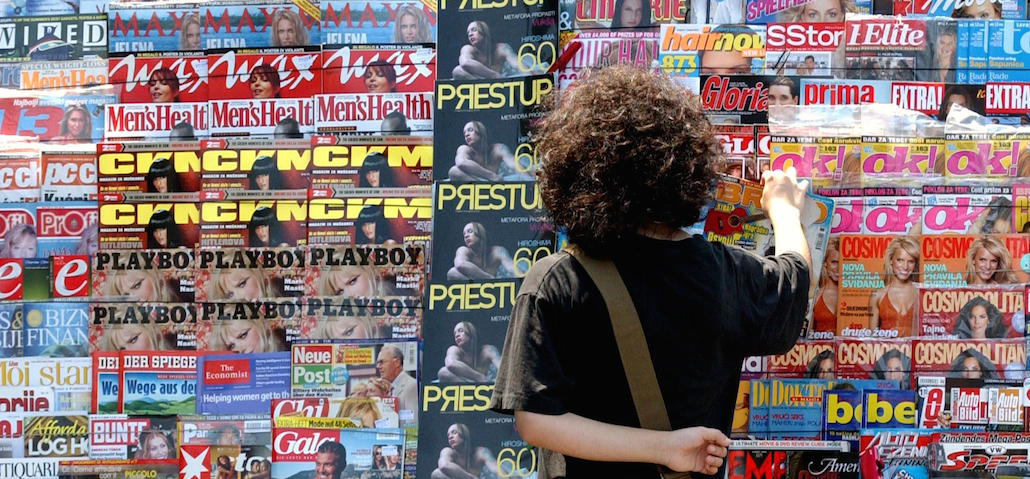Save 50% on a 3-month Digiday+ membership. Ends Dec 5.

It’s hard out there for magazines. Print advertising revenue has dropped 25 percent since 2008 as advertisers move over to digital, giving observers a lot of reason to believe that the print world is in deep trouble.
Hold that thought. Mary Berner, CEO and president of MPA — The Association of Magazine Media, isn’t convinced that the naysayers know the full picture. Since joining the MPA in late 2012, she has pushed for magazine companies to decouple their identities from the printed page: Magazines should be selling “magazine media,” not just print products themselves.
“We’re in the business of disseminating content through our brands. That can be anything from a print magazine to a video, to a digital experience,” she said.
Berner, who has helped build and lead brands like Glamour, TV Guide, Women’s Wear Daily and Details said that the magazine world is in a better position now than it has been in a long time. Here’s how she defends the industry.
Is the magazine industry in decline?
I’d actually say the magazine industry is uniquely positioned to do well. There’s been a convergence of all media: Everybody is in the entire ecosystem and on every platform. And what is becoming truer and truer is that strong brands prevail across every platform. Magazines tend to be the first place that consumers go when they look for content online. The hardest thing to do is build brands across platforms — and magazines have that down cold. That’s our advantage. If you don’t screw it up, there’s lot of possibility.
But that’s not how many observers see things. How did the magazine industry lose control over that “magazines are dead” narrative?
We never told the story. When I got here, we were only reporting the print numbers — we never added in the iPad and the Web numbers. We didn’t tell the story of the cross-platform, full magazine brand ecosystem. We just did a crappy job of PR-ing it. The bumps were real, but the industry is very resilient and got it together and figured out what the core value was.
You’ve said many times that their storied brands are magazines’ greatest assets. Why are brands so important?
Brand is an incredibly powerful advantage. When I was publisher at TV Guide years ago, you couldn’t get TV listings anywhere else. The brand was great, but the service we provided was unequaled. As people can get information about things in different places, the brand can’t completely carry it. You have to really give consumers something they can’t get somewhere else, especially because you charge for content.
Ad position: web_incontent_pos1
What about the news weeklies? Time and Newsweek have strong brands, but people aren’t reading them as much as they once did. Do they still have a place?
There’s always a place for a well-thought-out, informed point of view edited by really smart people. You can say that news is ubiquitous, but trusted points of view are not. That’s what the news weeklies have an opportunity to provide. There’s a difference between knowing something happens and understanding why it’s happening. Much of digital media is about knowing what happens. If you’re the kind of person who wants to understand or think more deeply about something — that’s where the news weeklies do an extraordinary job.
A handful of digital-first publishers are now starting, rather counterintuitively, to offer print products. Why do you think that is?
I think it’s because they understand that to get the attention of a consumer, you need an experience that’s more immersive. Print magazines are the anchor of any brand. You can tell a story in a different way. It’s got the longevity; its sits around your house. This is also why all the retailers have publications. They want to immerse customers in that experience.
Where do the advertisers fit in here? Many of them are going online. Why stick around with print?
Print magazines are the only experience where consumers consider the advertising as an integral and desired part of the content experience. When you’re reading a magazine, you like the ads and you want the ads there as a part of your experience. No other media can say that, except the Super Bowl. Sixty-three percent of people say that magazines will be a worse experience without the ads.
Who is going to figure things out first: The print-turned-digital publishers or the digital natives that are building their brands?
Really, it’s anyone’s guess. Even if I didn’t have this job, I’d certainly vote for the magazine companies. They do three things really well. They’re brand-builders, they understand what great journalism is, and they are also the best packagers of advertising programs in any of the media. Where they aren’t as good as the pure digital players is the actual technology side. And I would argue that that’s the easiest thing to buy.
Image via bibphoto/Shutterstock
More in Media

Digiday+ Research Subscription Index 2025: Subscription strategies from Bloomberg, The New York Times, Vox and others
Digiday’s third annual Subscription Index examines and measures publishers’ subscription strategies to identify common approaches and key tactics among Bloomberg, The New York Times, Vox and others.

From lawsuits to lobbying: How publishers are fighting AI
We may be closing out 2025, but publishers aren’t retreating from the battle of AI search — some are escalating it, and they expect the fight to stretch deep into 2026.

Media Briefing: Publishers turn to vertical video to compete with creators and grow ad revenue in 2026
Publishers add vertical video feeds to their sites to boost engagement, attract video ad spend and compete with news creators.
Ad position: web_bfu


